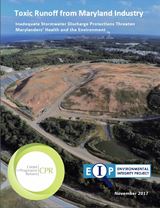Toxic Runoff in Maryland
Industrial Sites Ignoring Law, Polluting Communities and Waterways
A law enforcement culture that is soft on polluters and a state permitting system riddled with loopholes is leaving Maryland communities and waterways at risk from the toxic mix of rainwater and chemicals that wash off of old cars in junkyards and out of landfills or agricultural supply sites across the state.
According to a November 2017 report from the Center for Progressive Reform and the Environmental Integrity Project, more than 900 industrial facilities in Maryland are subject to the state’s industrial stormwater “general permit,” a critical tool developed by the Maryland Department of the Environment (MDE) to achieve the Clean Water Act’s fundamental goals of prohibiting toxic water pollution and restoring vibrant local waterways. These 900 facilities can be found in urban and rural areas, from Maryland’s westernmost counties all the way to the shore. But many of them are concentrated in low-income communities, raising concerns about the social justice implications of MDE’s weak enforcement and permitting programs.
The key to Maryland’s industrial stormwater general permit is that facilities are required to get a permit to pollute, then live within its limits. The facilities that pollute the most are required to test their polluting discharges and then report to the state on whether they’re within legal limits.
The report finds, however, that more than a third of the industrial facilities required by their permits to report results of stormwater runoff pollution testing are discharging such toxic metals as lead and copper in excess of legal limits, threatening the health of local residents, wildlife, and the Chesapeake Bay.
In addition, the report finds that about 14 percent of facilities with such permits don’t bother to report the results of testing, if indeed they’re conducting tests at all, meaning that, all told, close to half of the facilities required to report on their stormwater runoff aren’t in full compliance with the law.
That kind of rampant failure to follow the law is only possible when enforcement is feeble, and that’s exactly what the authors of Toxic Runoff from Maryland Industry found. Although the state’s environmental policy is generally regarded as progressive, it has begun turning its back on deterrence-based enforcement, following in the footsteps of the federal government. As of September 2017, the Maryland Department of the Environment (MDE) had only inspected 54 percent of the facilities that reported excessively polluted discharges. In addition, between 2014 and 2017, MDE inspected only 42 percent of the industrial facilities that had failed to file required reports on their polluting discharges, raising the possibility that these companies could be discharging untold quantities of toxic pollutants into the state’s waterways.
As is often the case, the burden from pollution highlighted in the report hits the state’s low-income communities hardest because the industrial facilities doing the polluting are often sited right on their doorsteps. CPR Policy Analyst David Flores, a co-author of the report, noted that low-income areas of East Baltimore, Prince George’s County, Salisbury, and Anne Arundel County are particularly hard hit.
Among the more egregious examples of polluters’ failure to comply with their permits:
- Cambridge Iron and Metal Company in East Baltimore discharged stormwater that contained lead that exceeded acceptable levels by an average of 717 percent.
- Potomac German Auto in Frederick had stormwater with aluminum that exceeded acceptable levels by 1,127 percent.
- Salisbury Scrap Metal, Inc., on the Eastern Shore had stormwater with copper that exceeded acceptable levels by 1,564 percent.
- The Southern States agricultural supplies outlet in North Cumberland, MD, had zinc in its runoff that exceeded acceptable levels by an average of 1,378 percent.
For more:
- Read the report, Toxic Runoff from Maryland Industry: Inadequate Industrial Discharge Protections Threaten Marylanders’ Health and the Environment, by CPR’s Rena Steinzor, David Flores, and Evan Isaacson, and the Environmental Integrity Project’s Sylvia Lam and Courtney Bernhardt.
- Read the day-of release blog post, and the news release.
- Read inspection reports from three of the industrial facilities we highlight in our report: the Quarantine Landfill in Baltimore, Y&R Eastside Auto Recycling in Baltimore, and AMG Resources (metal recycling) in Dundalk.
The Center for Progressive Reform is a nonprofit research and educational organization with a network of Member Scholars working to protect health, safety, and the environment through analysis and commentary. The organization's 50+ Member Scholars -- working academics at institutions of higher learning across the United States -- provide research, analysis and commentary on a range of issues related to the environment, health and safety.

